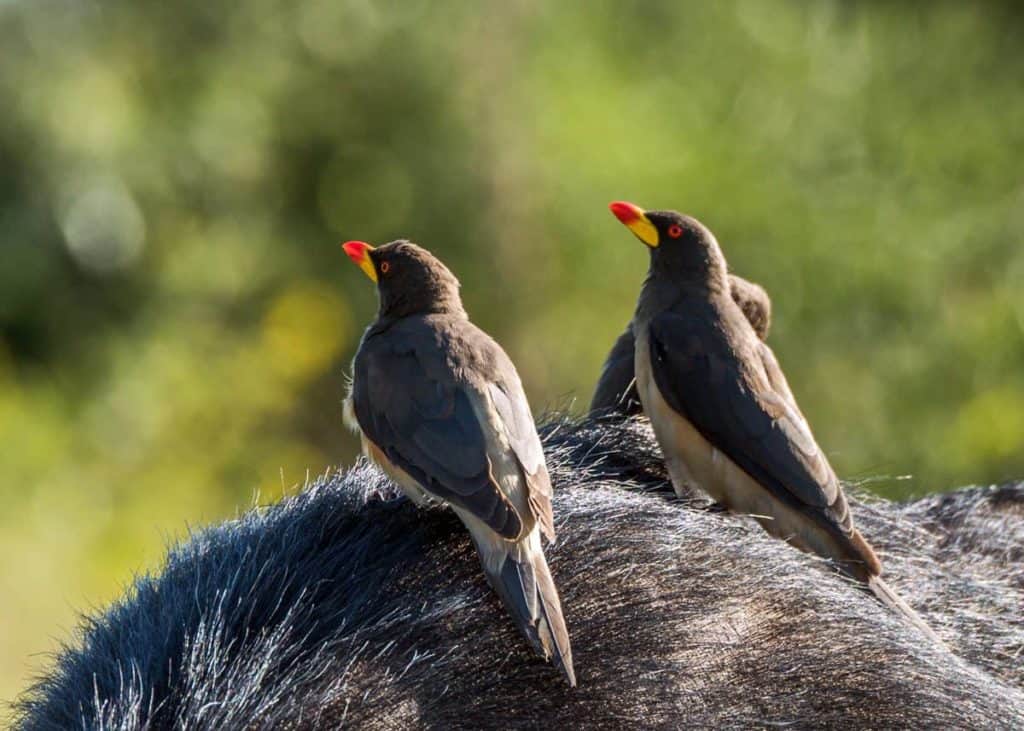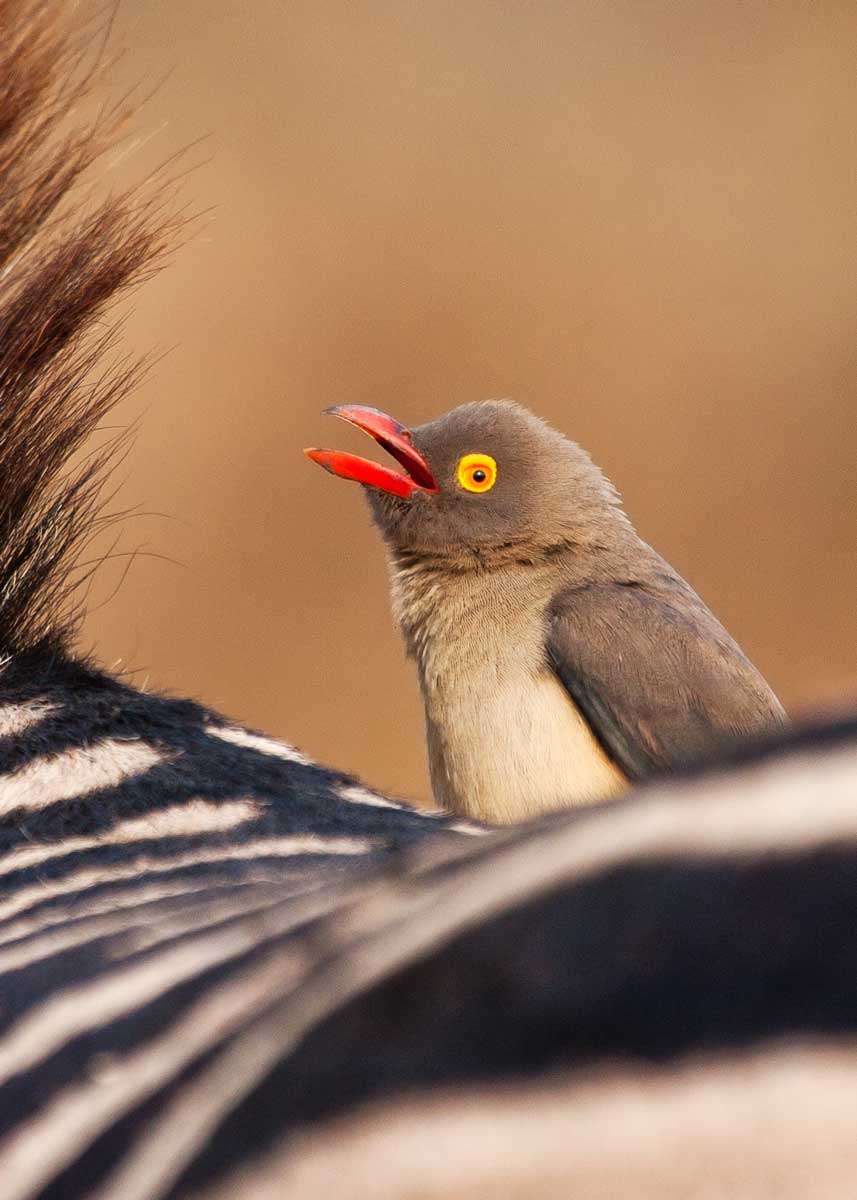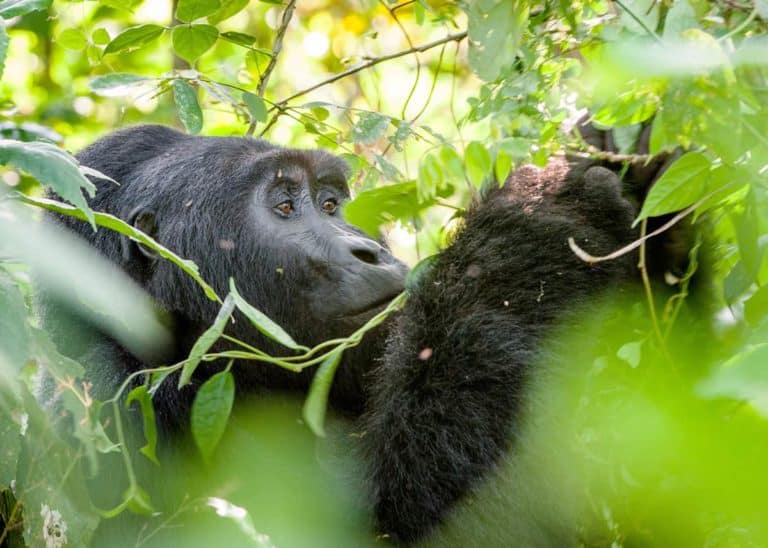19 Facts About African Oxpecker Birds (Both Species of Buphagus)
Have you seen little birds on rhinos and hippos? They are oxpeckers – small parasite-eating birds from Africa. Here are 19 oxpecker bird facts, including diet, symbiotic relationships with hippos, zebras, rhinos, and differences between the species.
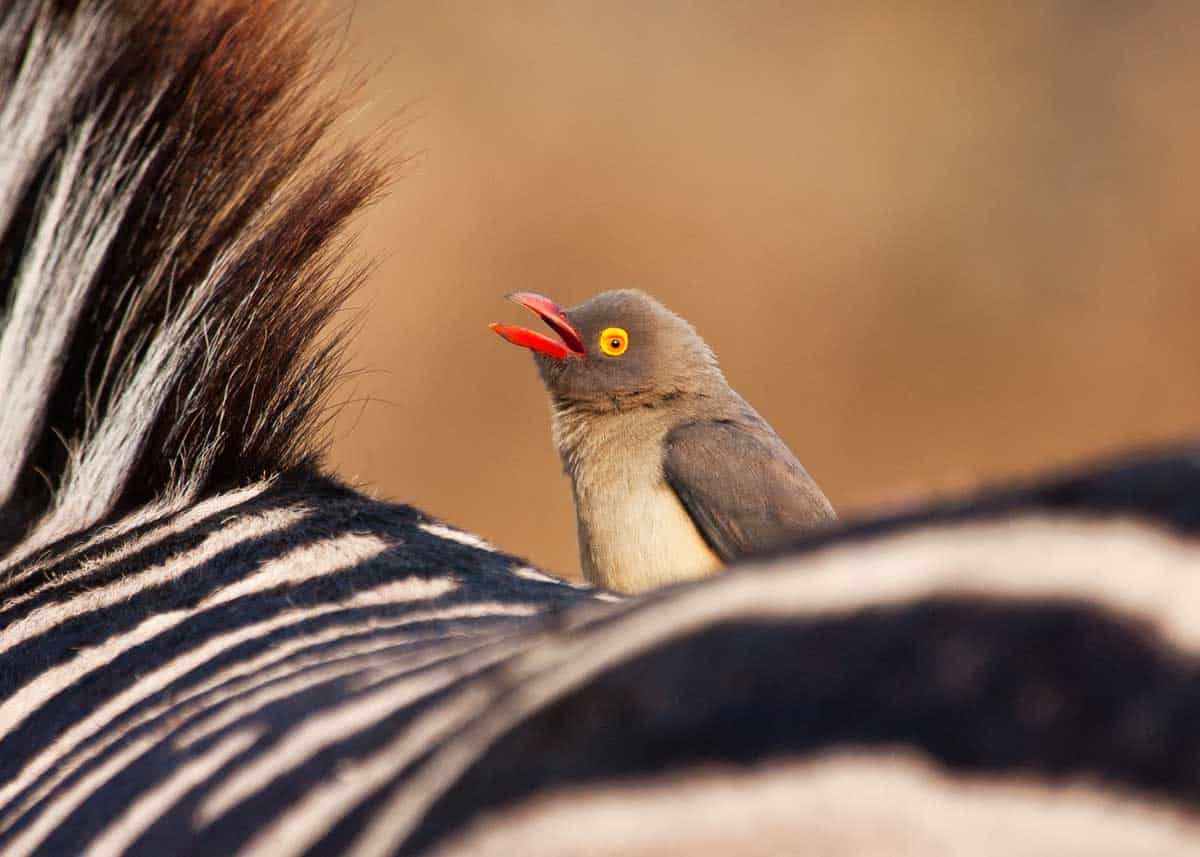
1. What does an oxpecker look like?
Oxpeckers are small, parasitic birds that grow around 7 – 9 inches tall. They’re predominantly brown with a lighter underbelly that can range from a murky gray to a beige or cream.
They have two big splashes of color on their bodies. One is located around the eyes, which have stark black pupils surrounded by yellow or orange rings. The other color is found on their beaks.
Red-billed oxpeckers have solid red beaks while yellow-billed oxpeckers have yellow beaks with red tips.
2. How many species of oxpeckers are there?
There are two species of oxpecker:
- Yellow-billed oxpecker (Buphagus africanus)
- Red-billed oxpecker (Buphagus erythrorynchus)
Since they’re quite similar, they’re sometimes mistaken for each other in the wild.
3. What is the difference between a red and yellow billed oxpecker?
The main difference between the two oxpecker species is their beak.
- Like their name suggests, the red-billed oxpecker has a red beak
- And the yellow-billed oxpecker has a yellow beak with a red tip.
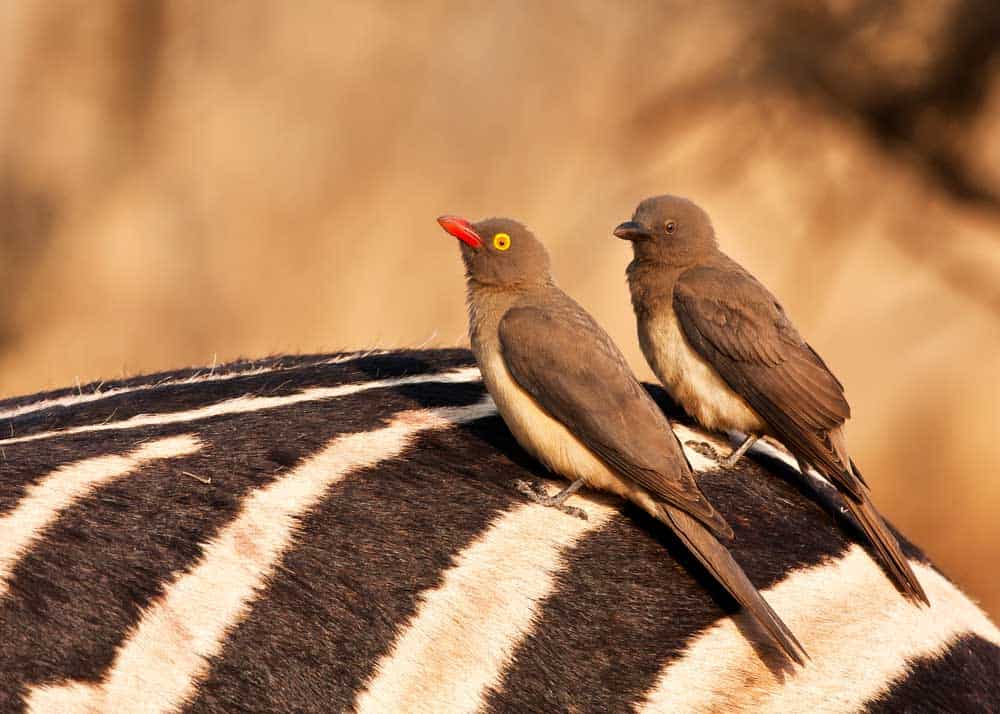

Another difference is their location.
- The red-billed oxpecker sticks to eastern Africa
- The yellow-billed oxpecker can be found all over sub-Saharan African in the east and west.
There aren’t any hard and fast boundaries between the species, however. Some scientists have even caught them mingling in the same habitats.
4. What is the scientific name for oxpecker birds? What does it mean?
The genus for the oxpecker is Buphagus. This is a combination of the Greek words for “ox” (bous) and “eating” (phagos). They got this moniker from a zoologist way back in 1760, so they’ve been munching on bugs for centuries.
Here are the Latin names for each species:
- Yellow-billed oxpecker (Buphagus africanus)
- Red-billed oxpecker (Buphagus erythrorynchus)
5. What other names do oxpeckers have?
Oxpeckers are sometimes known as “tickbirds” since ticks can make up a large portion of their diet.
However, because they eat other insects as well, the name isn’t entirely accurate.
6. Where do oxpeckers live?
Oxpeckers are native to Africa. They’re found in sub-Saharan countries like Kenya, Ethiopia, Uganda, Botswana, Zimbabwe, Sudan, and Somalia.
While the two species can sometimes occupy the same area, they do have separate ranges. The red-billed oxpecker likes eastern Africa while the yellow-billed oxpecker lives both east and west.
7. What is the habitat of the oxpeckers?
Since they’re dependent on large mammals to survive, oxpecker birds tend to live where their “hosts” live. They prefer open habitats like grasslands and savannas, but they’ll go anywhere except deserts. Those are too hot for them.
8. Are oxpecker birds endangered?
No, oxpeckers aren’t endangered.
This is good news for these little critters! They’re doing just fine in the wild. The International Union for the Conservation of Nature (IUCN) rates oxpecker birds as “least concern” on the extinction scale.
9. What do oxpeckers eat?
Oxpeckers eat the insects that live on the bodies of their hosts. They’ll eat ticks, flies, maggots and all kinds of larvae.
They’ve also been known to eat the flesh and blood of their hosts, mostly by pecking at their wounds. The following video shows a little of that behavior (at around 1:33 – 1:47) so if it sounds disturbing to you, maybe you’ll want to skip that part.
As you can see from the video, they aren’t always the peaceful passengers depicted by movies and cartoons. They can get quite aggressive when it comes to feeding.
10. On what animals does the oxpecker feed?
Oxpeckers feed on large mammals like rhinos, zebras, hippos, cape buffalo, elephants, giraffes and wildebeests. In domestic areas, they’ll feed from cattle and other farm animals.
Oxpeckers tend to avoid smaller creatures like duikers and reedbucks, which might be related to the number of insects that they can scavenge from them. Smaller bodies mean less food.
A full-grown oxpecker can eat hundreds of bugs or thousands of larvae per day!
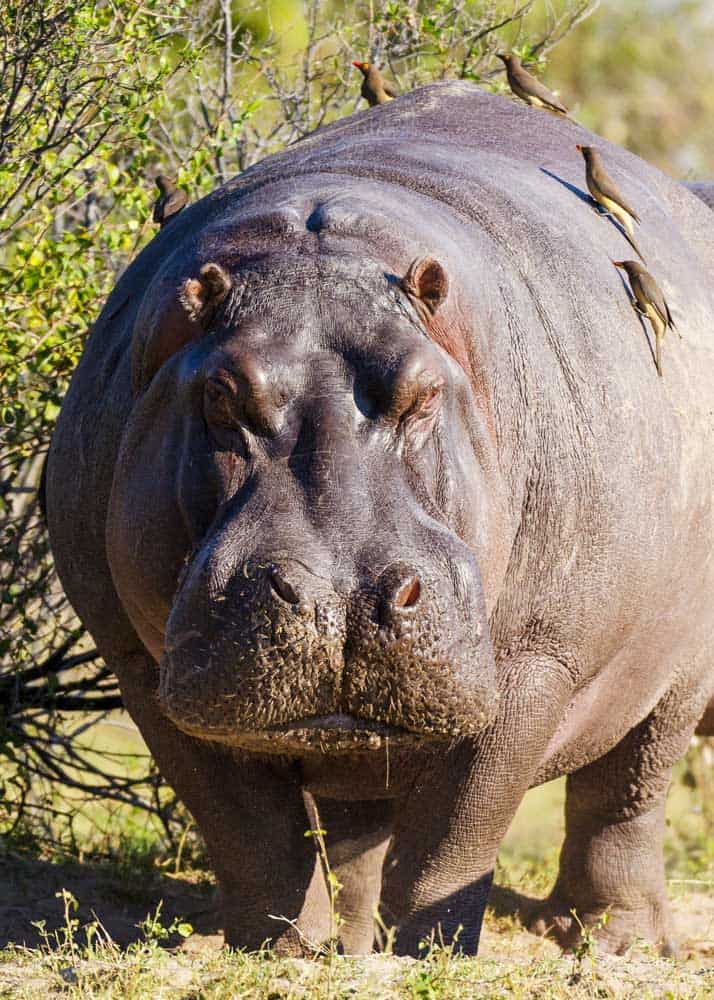
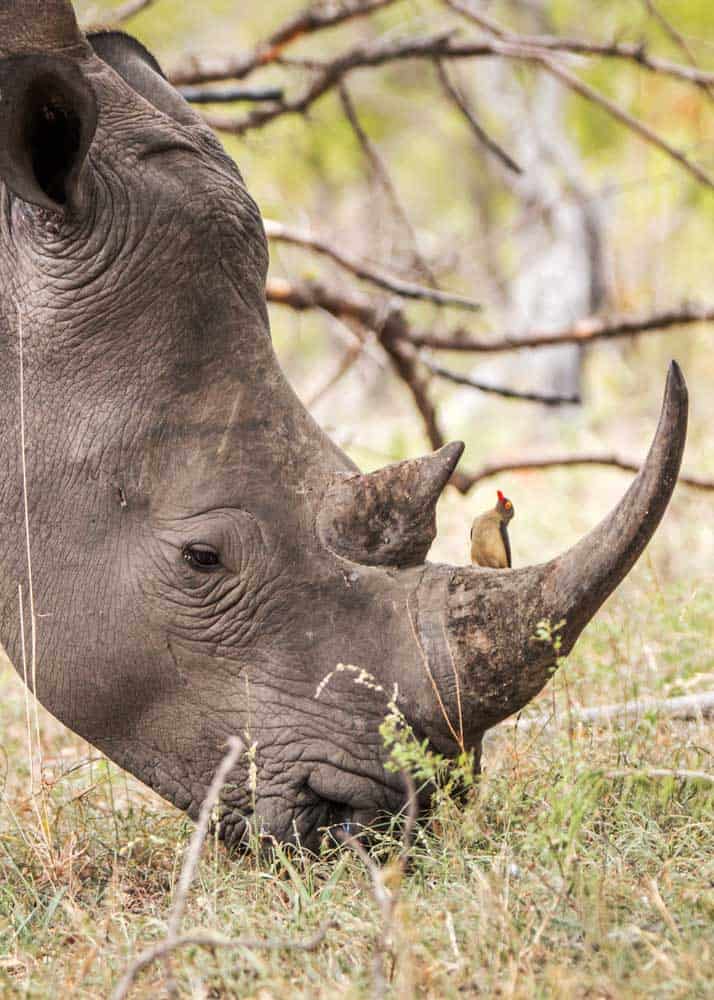
11. Do oxpeckers eat blood?
Yes, oxpeckers eat blood.
They get it from the full-bellied ticks that they snatch off their hosts, and from any wounds or sores that their hosts have in order to feed on the blood and eat the damaged tissue.
12. Do oxpeckers take anything else from their hosts?
In addition to food, oxpeckers will also dig on their hosts to remove hair and fur. They use the soft fuzz to line their nests. Some will even pluck the wool of sheep that they don’t feed from just to get the good stuff.
13. Why do oxpeckers make such loud noises?
Some oxpeckers act as warning systems for their hosts.
When a predator is nearby, they’ll make high screeching sounds that warn of the oncoming danger, and the hosts will know to get a move on. This can be life-saving for animals like the rhinoceros that have terrible eyesight.
14. How big is an oxpecker? How much do they weigh?
Oxpeckers are small birds, so they max out around 7 to 9 inches (18 to 23 cm) tall. They weigh less than two ounces (54 grams).
15. What’s the lifespan of an oxpecker?
The lifespan of the oxpecker hasn’t been confirmed, but it’s assumed to be about 15 years. This would match similar birds that their genus is related to, including mockingbirds, thrashers and starlings.
16. How often do oxpeckers breed?
Not a lot is known about oxpecker reproduction, but it seems to take place most often in the rainy season, so it might be related to the movements of their hosts and the “tick loads” that they carry.
They’ve been known to mate right there on their hosts.
17. Where do oxpeckers make their nests?
Oxpeckers like to nest in holes. It can be in a tree, cave, cliff or even a barnyard wall. The most important thing is that it provides a cavity where they can stuff fur and grass to make it soft.
18. How many eggs do they lay?
The typical clutch of a yellow-billed oxpecker is 2 – 3 eggs, but the red-billed oxpecker can lay up to 5. They’re small and white with brownish spots.
19. Are oxpeckers considered parasites?
There’s a debate in the scientific community about the true relationship between oxpeckers and their hosts.
For a long time, it was considered an example of mutualism. This is a relationship between two plants or animals where both parties benefit in some way. For example, when a bee feeds from a flower and helps it pollinate, that’s a mutually beneficial action.
Oxpeckers help their hosts in several ways. They clear off ticks, mites, and other parasites, and their calls can serve as warnings when predators are nearby.
However, recent research suggests that oxpeckers can also be bad for their hosts:
- They can create or worsen injuries in order to feed on the blood from them.
- Sometimes, they don’t eat ticks until after the ticks have already fed on the host’s blood.
- Some hosts are highly irritated by them and try to shake them off whenever they land.
All of these things are the behavior of parasites, not mutually beneficial friends.
Learn more about giraffes: Guide to Giraffe Species
The Life and Times of the Oxpecker
Oxpeckers are curious little creatures that the world doesn’t entirely understand. However, one thing is for sure: They’re much more complex than people think! Keep that in mind the next time that you see an oxpecker bird chilling on the antlers of a great African beast.

